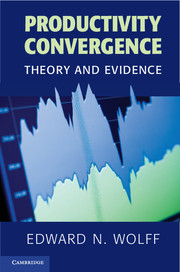Book contents
- Frontmatter
- Contents
- Acknowledgments
- 1 Introduction
- 2 An Overview of Modern Growth Theory
- 3 The Measurement and Estimation of Productivity Growth
- 4 Long-Term Record among the Advanced Industrial Countries
- 5 Postwar Record on Productivity Performance on the Aggregate Level among the Advanced Industrial Countries
- 6 Further Details on the Role of Education and Technology in the Productivity Performance among the Advanced Industrial Countries
- 7 Productivity Performance on the Industry Level among the Advanced Industrial Countries
- 8 The Productivity Slowdown
- 9 Postwar Economic Performance among Countries of the World
- 10 Recapitulation and Future Prospects for Growth
- Bibliography
- Index
10 - Recapitulation and Future Prospects for Growth
Published online by Cambridge University Press: 05 June 2014
- Frontmatter
- Contents
- Acknowledgments
- 1 Introduction
- 2 An Overview of Modern Growth Theory
- 3 The Measurement and Estimation of Productivity Growth
- 4 Long-Term Record among the Advanced Industrial Countries
- 5 Postwar Record on Productivity Performance on the Aggregate Level among the Advanced Industrial Countries
- 6 Further Details on the Role of Education and Technology in the Productivity Performance among the Advanced Industrial Countries
- 7 Productivity Performance on the Industry Level among the Advanced Industrial Countries
- 8 The Productivity Slowdown
- 9 Postwar Economic Performance among Countries of the World
- 10 Recapitulation and Future Prospects for Growth
- Bibliography
- Index
Summary
Introduction
In this chapter I summarize the major findings of the book and speculate on “lessons to be learned” and future prospects for growth around the world. I first review the basic results on convergence around the world and among OECD countries in particular both over the long term and over the postwar period (Section 10.2). In the next two sections I summarize the evidence on the factors that have been found to play a role in the convergence process. I divide the myriad factors into two groups. The first of these, what I have called “strong forces,” are discussed in Section 10.3. These include the catch-up effect (the initial productivity level), capital formation, education, R&D and technological spillovers, and basic social and political institutional factors. These factors explain the vast majority of the variation in the growth rates of GDP per capita or productivity (by some estimates as much as 90 percent).
The second set of factors, which I have termed “weak forces,” is discussed in Section 10.4. These comprise almost all the other variables used in the analysis of convergence. These include international trade and FDI, the role of democracy and political institutions, inequality, financial development, geography and resource availability, regulation, structural change, and foreign aid. These factors collectively might account for another 5 percent of the variation in the growth rates of GDP per capita or productivity. One odd feature of the research in this area is that there seems to be an inverse relation between the amount of work done on a subject (inequality, for example) and its importance as a determinant of growth.
- Type
- Chapter
- Information
- Productivity ConvergenceTheory and Evidence, pp. 430 - 464Publisher: Cambridge University PressPrint publication year: 2013



